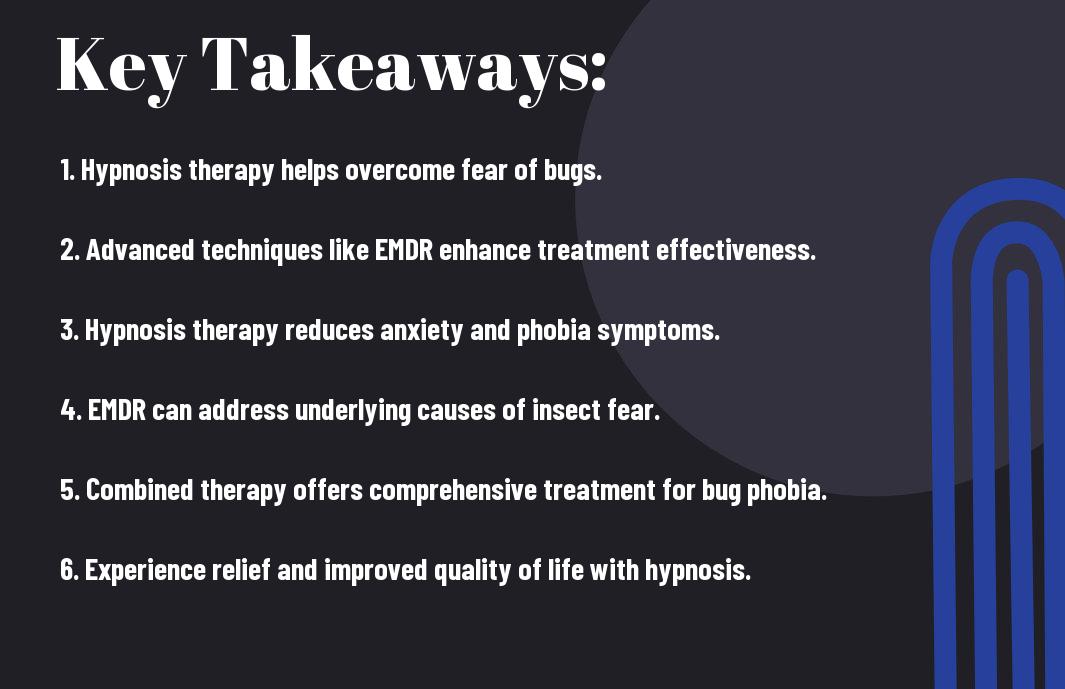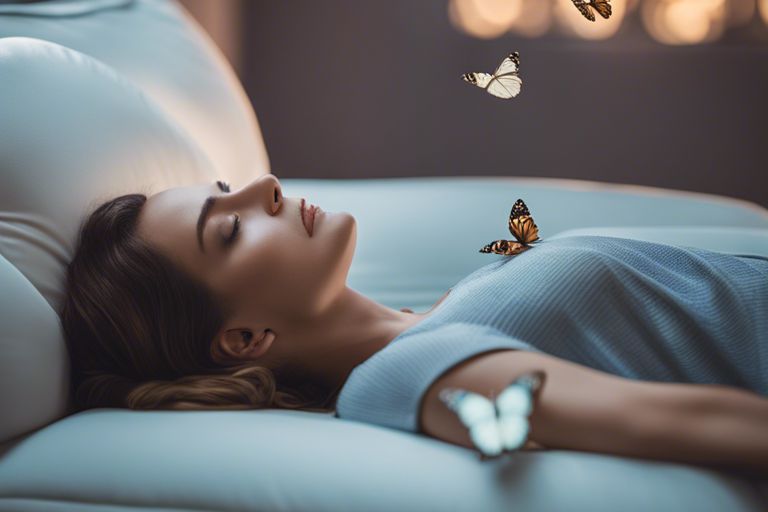Advanced hypnosis and powerful EMDR to quickly remove the fear of bugs!
Just imagine a life free from the overwhelming fear and anxiety triggered by insects. For individuals struggling with entomophobia, also known as the fear of bugs, advanced hypnosis therapy and Eye Movement Desensitization and Reprocessing (EMDR) offer effective solutions to overcome this debilitating phobia.
Through advanced hypnosis therapy techniques, individuals can rewire their subconscious mind to reduce fear responses, allowing them to confront and manage encounters with insects more calmly and confidently. Additionally, EMDR therapy can help individuals process past traumatic experiences related to bugs, ultimately diminishing the intense anxiety associated with insects. Embracing these innovative therapeutic approaches can lead to a significant improvement in one’s quality of life, enabling them to engage in outdoor activities and social events without the constant fear of encountering insects.
Key Takeaways:
- Hypnosis therapy: Advanced hypnosis can help individuals with entomophobia overcome their fear of insects by addressing the underlying causes and changing their perception of insects.
- EMDR therapy: Eye Movement Desensitization and Reprocessing (EMDR) therapy can be used alongside hypnosis to help individuals process traumatic experiences related to insects and reduce anxiety.
- Combination therapy: Utilizing a combination of hypnosis and EMDR therapy can provide a comprehensive approach to treating entomophobia and addressing both emotional and cognitive aspects of the fear.
- Effective treatment: Research has shown that hypnotherapy, EMDR therapy, and other techniques can effectively reduce symptoms of entomophobia and improve the quality of life for individuals struggling with the fear of bugs.
- Professional guidance: Seeking help from a mental health professional who specializes in specific phobia disorders can provide individuals with the support and tools needed to overcome entomophobia and lead a more fulfilling life free from fear.


The Science of Phobias
Definition and Types of Phobias
Even though phobias are considered a type of anxiety disorder, they differ from general feelings of anxiety due to their specific trigger. Phobias involve an overwhelming fear of a particular object, event, or situation, causing individuals to experience extreme anxiety or fear that is disproportionate to the actual threat.
An individual can experience various types of phobias, ranging from entomophobia (fear of insects) to acarophobia (fear of mites) and arachnophobia (fear of spiders). Assume that approximately 1 in 5 teenagers will deal with a specific phobia disorder in their lifetime.
| Entomophobia | Fear of insects |
| Acarophobia | Fear of mites |
| Arachnophobia | Fear of spiders |
| Other phobias | Related to specific insects |
| Data | 1 in 5 teenagers may experience phobia disorder |
The Biological and Psychological Basis of Entomophobia
Entomophobia is a fear of insects that can be deeply rooted in past traumatic experiences, environmental irritations, family history, or modelling behaviours. Individuals with a predisposition to anxiety disorders, panic disorder, or substance use disorder may be at higher risk of developing entomophobia.
Phobias can manifest in a variety of ways, from emotional symptoms such as excessive fear and avoidance of insect-related situations to physical symptoms like tremors, sweating, and heart palpitations. Severe entomophobia can lead to panic attacks and negatively impact daily life activities.
Basics of Hypnosis
Now, let’s investigate the fundamentals of hypnosis. Hypnosis is a therapeutic technique that dates back centuries, with roots in ancient civilizations. It involves inducing a trance-like state of heightened focus and concentration, where the individual is more open to suggestion. In the context of therapy, hypnosis can be a powerful tool for addressing deep-rooted fears and phobias.
Historical Background of Hypnosis in Therapy
Historically, hypnosis has been used as a therapeutic tool for various mental health conditions, including phobias. In the treatment of specific phobias like entomophobia, hypnotherapy can help individuals explore the underlying causes of their fear and reframe their perception of insects. By tapping into the subconscious mind, hypnotherapy aims to address the root cause of the phobia and facilitate lasting change.
How Hypnosis Can Address Phobias
For individuals struggling with entomophobia, hypnosis therapy offers a unique approach to overcoming their fear of insects. Hypnosis can help individuals reframe their beliefs and emotions surrounding insects, fostering a sense of empowerment and control. By accessing the subconscious mind, hypnotherapy can target the deep-seated fears and anxieties that contribute to the phobia, leading to long-lasting relief and resilience.
With advanced hypnosis techniques, individuals can experience profound shifts in their perception of insects and their phobias. By combining the principles of hypnotherapy with evidence-based practices, such as exposure therapy and cognitive behavioural therapy, individuals can address their entomophobia from a holistic perspective. The process of hypnotherapy for phobic disorders involves guiding individuals into a relaxed state where they can explore and reframe their fears in a safe and supportive environment, ultimately leading to profound healing and transformation.
Advanced Hypnosis Techniques
Unlike traditional therapy methods, advanced hypnosis techniques offer a unique approach to treating specific phobias such as entomophobia. Research studies, such as Treatment of a Woman With Emetophobia: A Trauma …, have shown the efficacy of these methods in alleviating deep-rooted fears and anxieties. Through a combination of hypnosis therapy and Eye Movement Desensitization and Reprocessing (EMDR), individuals can experience profound changes in their response to triggers.
| Progressive Relaxation and Visualization | Direct and Indirect Suggestions for Overcoming Fear |
| With progressive relaxation and visualization techniques, individuals are guided to deeply relax their body and mind, creating a safe space to explore underlying fears. By visualizing positive outcomes and reprogramming subconscious beliefs, clients can gradually reduce their fear response towards insects. | For direct and indirect suggestions in overcoming fear, hypnotherapists use carefully crafted language to instill confidence and courage in individuals. Through subtle cues and affirmations, clients can reframe their perception of insects and build resilience against future triggers. |
Post-Hypnotic Suggestions and Reinforcement
For post-hypnotic suggestions and reinforcement, hypnotherapists implant empowering suggestions during the hypnotic state. These suggestions continue to resonate with the individual even after the session, reinforcing positive beliefs and behaviours. By harnessing the power of the subconscious mind, individuals can anchor feelings of calmness and control in the face of insects. This transformative process allows individuals to break free from the constraints of entomophobia and embrace a newfound sense of freedom and empowerment. Through personalized hypnosis sessions tailored to individual needs, clients can experience lasting relief from their fear of insects. By addressing the root causes of phobias and enhancing inner resources, individuals can reclaim their confidence and live fearlessly.
Customizing Hypnosis to Individual Needs
Directly customizing hypnosis to individual needs involves tailoring each session to address specific triggers and responses unique to the client. By understanding the intricate interplay between the conscious and subconscious mind, hypnotherapists can craft personalized scripts and techniques to guide individuals toward lasting transformation. Through this personalized approach, clients can unlock their full potential and cultivate a profound sense of self-mastery. Another cornerstone of advanced hypnosis therapy lies in its ability to offer a holistic approach to healing, integrating mind, body, and spirit in the journey toward overcoming phobias. With a focus on empowerment and well-being, advanced hypnosis techniques pave the way for individuals to flourish and thrive in all aspects of their lives.

Fundamentals of Eye Movement Desensitization and Reprocessing (EMDR)
Origins of EMDR Therapy
Many individuals suffering from specific phobias, such as entomophobia (fear of insects), can find relief through Eye Movement Desensitization and Reprocessing (EMDR) therapy. First developed by Francine Shapiro in the late 1980s, EMDR has since been widely recognized as an effective treatment for trauma and phobias.
Mechanisms of Action in EMDR
Movement in Eye Movement Desensitization and Reprocessing (EMDR) therapy involves stimulating bilateral brain activity through visual or auditory cues while focusing on distressing memories or triggers. This unique approach allows individuals to reprocess traumatic experiences and desensitize the emotional impact associated with them, leading to significant symptom reduction and emotional healing.
With EMDR, individuals are guided through a series of structured phases designed to facilitate the adaptive processing of traumatic memories. These phases include preparation, assessment, desensitization, installation, and body scan.
Phases of EMDR Treatment
With a structured approach, EMDR therapy progresses through distinct phases aimed at targeting and reprocessing specific traumatic memories. This systematic process enables individuals to address deep-rooted fears and phobias, such as entomophobia, with precision and efficacy.
EMDR for the Treatment of Entomophobia
Preparation and Assessment for EMDR
Preparation: After identifying entomophobia as a significant fear, individuals can consider Eye Movement Desensitization and Reprocessing (EMDR) therapy as an effective treatment option. Before starting EMDR sessions, a thorough assessment will be conducted by a trained mental health professional to understand the specific triggers and severity of the phobia.
Desensitization and Reprocessing of Fear Triggers
Any: Once the assessment is complete, the EMDR therapist will guide the individual through desensitization and reprocessing of fear triggers related to insects. This process involves recalling traumatic experiences or distressing memories while focusing on bilateral stimulation techniques to assist in reprocessing the fear response.
Treatment: The desensitization and reprocessing of fear triggers is crucial in helping individuals with entomophobia gradually reduce their anxiety and fear responses towards insects.
Installation and Body Scan Procedures
For: During EMDR therapy sessions, the installation and body scan procedures are utilized to reinforce positive beliefs and sensations while systematically scanning the body for any residual tension or discomfort related to the fear of insects. This aids in creating a sense of safety and calmness.
A: The installation and body scan procedures in EMDR therapy play a vital role in reshaping the individual’s mindset towards insects and promoting relaxation and confidence in managing their phobia.
Measuring EMDR Efficacy in Phobia Treatment
Body: Researchers have found that EMDR therapy can be highly effective in treating specific phobias like entomophobia. Studies have shown significant reductions in fear and anxiety levels, allowing individuals to regain control over their responses to insect-related stimuli.
EMDR: When combined with hypnosis therapy, EMDR provides a comprehensive approach to addressing entomophobia by targeting the underlying fears and traumatic experiences associated with insects, ultimately leading to lasting positive outcomes for individuals seeking relief from their phobia.
Integrating Advanced Hypnosis and EMDR
Once again, the combination of advanced hypnosis therapy and Eye Movement Desensitization and Reprocessing (EMDR) has shown promising results in treating phobias such as the fear of bugs. By integrating these two powerful techniques, we can effectively address the underlying causes of entomophobia and help individuals overcome their debilitating fear.
-
Focus on: Benefits: Customized Hypnosis Sessions Target-specific phobia triggers EMDR Techniques Help process traumatic experiences -
Case Selection Criteria for Combined Approach
Any successful treatment plan starts with a thorough assessment of the individual’s phobia, including the severity and root causes. Identifying the right candidates for the combined approach of hypnosis and EMDR is crucial for achieving optimal outcomes. By carefully selecting cases that can benefit from both modalities, we can tailor the treatment to address the unique needs of each individual. -
Sequential or Concurrent Treatment: Best Practices
Sequential treatment involves using hypnosis therapy first to establish a foundation of relaxation and responsiveness before incorporating EMDR to address specific traumatic memories related to the phobia. This phased approach allows for a comprehensive healing process and maximizes the benefits of both modalities in the treatment of entomophobia. -
Ethical Considerations in Combined Treatment Approaches
Integrating advanced hypnosis and EMDR for the fear of bugs requires a careful consideration of ethical guidelines and best practices. It is imperative to ensure that the treatment is conducted ethically and responsibly, prioritizing the well-being and safety of the individual seeking help. Confidentiality, informed consent, and respect for autonomy are imperative principles to uphold in this combined therapeutic approach.
For instance, the integration of advanced hypnosis and EMDR offers a holistic and evidence-based approach to treating entomophobia by addressing both the conscious and subconscious aspects of the phobia. By combining these two powerful techniques, individuals can experience profound healing and long-lasting relief from their fear of bugs.
Self-Help Strategies and Support
Daily Practices for Managing Anxiety
Despite the fear of bugs being a challenging phobia to overcome, there are self-help strategies that individuals can use to manage their anxiety daily. Research shows that incorporating daily practices such as deep breathing exercises, progressive muscle relaxation, and visualization techniques can help reduce anxiety levels and promote a sense of calmness.
Mindfulness and Acceptance Techniques
Daily, individuals can practice mindfulness and acceptance techniques to help cope with the fear of bugs. By staying present in the moment and accepting their feelings without judgment, individuals can experience a sense of relief and reduced anxiety. Daily mindfulness practices, such as meditation and grounding exercises, can be beneficial in shifting focus away from fear towards a more peaceful state of mind.

Techniques such as body scanning and mindful breathing can help individuals connect with their bodies and emotions, creating a sense of detachment from the fear of bugs and promoting emotional well-being.
Building Resilience and Coping Skills
Skills such as building resilience and coping mechanisms can be valuable tools in managing the fear of bugs. For instance, developing a support network of friends and family who understand and validate the individual’s fear can provide a sense of security and encouragement. Additionally, engaging in activities that promote self-care and self-compassion, such as exercise, journaling, and relaxation techniques, can help individuals build resilience in the face of their phobia.
To wrap up
Now, for those struggling with entomophobia, advanced hypnosis therapy and Eye Movement Desensitization and Reprocessing (EMDR) can be highly effective treatments. Hypnosis therapy can help individuals reframe their perceptions of insects and reduce the fear response triggered by them. EMDR, on the other hand, can help process past traumatic experiences related to insects, leading to a decrease in fear and anxiety levels.
By seeking out these advanced therapies, individuals with entomophobia can find relief and overcome their fear of bugs. With the right guidance and professional support, it is possible to manage and eventually conquer this specific phobia, allowing individuals to live a more fulfilling and anxiety-free life.
FAQ
Q: What is advanced hypnosis therapy for the fear of bugs?
A: Advanced hypnosis therapy for the fear of bugs is a specialized treatment that utilizes deep hypnotic states to address and alleviate the intense anxiety and phobia associated with insects.
Q: How does EMDR complement hypnosis therapy in treating the fear of bugs?
A: Eye Movement Desensitization and Reprocessing (EMDR) is often used in conjunction with hypnosis therapy to enhance the effectiveness of treatment. EMDR helps process traumatic experiences related to insects, reducing the emotional charge and associated fear.
Q: What are the benefits of utilizing advanced hypnosis and EMDR for overcoming the fear of bugs?
A: By combining advanced hypnosis therapy and EMDR, individuals can experience profound healing and relief from their entomophobia. These techniques work synergistically to reframe negative beliefs, reduce anxiety reactions, and empower individuals to confront and overcome their fear of bugs.
The Official Instagram profile of Mind Spirit Body Hypnosis therapy. About the author: Award-winning Fanis Makrigiannis of Mind Spirit Body Hypnosis therapy is a certified Hypnotherapist and Master Practitioner of Neuro-linguistic Programming with the American Board of Hypnotherapy. Proudly serving Durham Region, The Greater Toronto Area, Peel Region, Ontario, Canada, and the United States of America via Zoom meetings.



